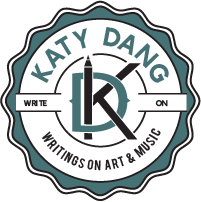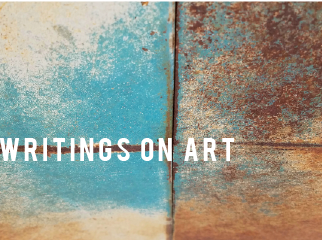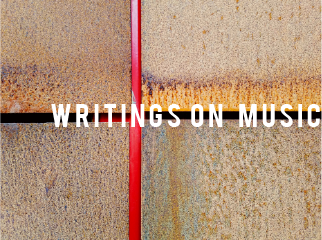Amy Westover
“Amy Westover’s ‘Tendency to Exist’”
By Katy Dang
Idaho Arts Quarterly | June 6, 2007
https://www.boiseweekly.com/boise/the-essence-of-place/Content?oid=932461
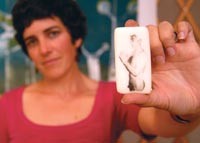
Amy Westover is an artist who has already lent her considerable talents to public art in Idaho. Her work thus far has demonstrated tremendous sensitivity to the specific site, an understanding of the needs of the space and a willingness to work with different materials to allow her vision to come to life. Each of her completed projects has led to further commissions, and her avenues for expression continue to unfold. She stands knee deep on the shore of a hugely promising career, both in the realm of public art and in her personal work with printmaking, lithography and glasswork. Westover has specific criteria that she applies to each of her public art projects. “I want the end result to somehow reflect the past, present and future of the site,” says Westover. Using this guideline allows her to create work that captures the essence of the places where she has erected her projects. Her vision invites exploration as it elucidates the area.
At the age of 28, she completed her first major public art piece, Grove Street Illuminated and the Boise Canal, which sits at the intersection of Ninth and Grove streets in downtown Boise. This piece is an accomplishment, both for Westover and for public art in Boise. For the city, it is a symbol of the potential for public art projects and has become a beloved landmark in a very short time. For Westover, it was the project that launched her squarely into the domain of site specific public art.
Growing up in Idaho and Arizona, there was little indication in her own past that art would be the path Westover would take. “It’s hard to say when it all started for me,” says Westover. “Looking back, I remember me as a little girl in my room, constantly rearranging my shelves, as if I was doing little installations.
“In college, I didn’t have a lot of direction, but my grandparents pushed me to stay in school,” she says. “So I did, and I discovered the art world.” In her third year of college at Boise State University, Westover found her inspiration. “One semester, I was floating through the schedule of classes and decided to take a watercolor class,” she says. “I had no expectations, but something happened. I picked up a paintbrush and started painting the same goddamned flower that everybody in that class has painted since time began, and that was it. It was as if I found the path that I was supposed to go down.

“The direction that I took in college was due to professors that I met and identified with,” says Westover. “There was Dwaine Carver in sculpture and George Roberts in printmaking.” Westover immediately took to both media. “Printing and sculpting weren’t stifling or controlled for me,” she recalls. “I was able to learn a lithography technique that allowed me to print on anything I wanted. There was no sense of ‘No, you can’t do that’ with George. It was always, ‘Do it. Try it. Bring in anything you want and let’s see what happens.’ That was exactly the kind of freedom that I was looking for … and I was mature enough to see what modern art and the art world are all about. It all made sense to me.”
Westover’s senior project was an installation titled Urban Sprawl, Population, and Influences. The piece featured 120 carrots hanging in rows, each printed with the image of a male with a “Sold” sign emblazoned on it. The mass produced, repetitive installation was designed to comment on the sameness and prevalence of urban sprawl, but it was Westover’s commitment to those carrots that led to her first big gig.
The installation won a Jurors Award at the Idaho Triennial in 2001 and became part of the traveling exhibition. This meant lots and lots of carrots had to be continually refreshed. Westover bought WinCo out of carrots numerous times, carefully choosing the ones with the most printable surfaces. In order to keep her installation up, she applied for a Quick Funds grant from the Idaho Commission on the Arts. She received the grant and in the process caught the attention of Barbara Robinson of the ICA.
At the same time, the Boise City Commission on the Arts was seeking artists to create the first public artwork. Karen Bubb, the public arts manager for the Arts Commission, asked several people in the art world to recommend artists for the project. Robinson referenced Westover.
“I have to admit I was very nervous about Amy, because she had never done anything like this before. I called her on the phone to let her know she had gotten the project, and then told her my concerns.” says Bubb. “Then I showed up on her doorstep with an enormous stack of books for her to read. The first thing that impressed me is that she read all those books. She was willing to listen to my fears, and then move forward.”
Westover started this project as she always does: by exhaustively researching the site of the proposed project. On a conceptual level, she implemented her criteria about the specific place. She provided the information for people to understand the site from its historical origins to the here-and-now, and to the suggestion of the future in the design. “That’s what is so important about public art,” says Westover. “I want to show what is relevant to the place right now, but also to build a bridge between these three understandings.”
One of the key components to the success of the project was the participation of Classic Design Studio. Owner Noel Weber was part of the team committed to producing the piece. He let Westover build it in his studio on Sixth and Myrtle, and put her in touch with the people who knew how to do what she wanted to do. “I wanted to use all of these different materials, so I decided I should take the opportunity to learn all of the techniques that I was interested in,” says Westover. One of Westover’s talents is that she respects other people’s expertise. She is able to learn from them but also to let them contribute their own talents. “Pacific Steel made the armature inside of the sculpture,” says Westover. “Chris Schofield was the welder and the genius behind putting things together. Skylar Pierce worked on the metal finishing. Mark Baltes did the silkscreening. Noel Jr., and Wil Kirkman worked with me on the glass and lighting. All of these people gave me their knowledge and dove right in.”
The project took nine months and was completed in 2002. “It really was my first baby,” says Westover. “I learned so much from it. It was a crash course in public art. I had to conduct weekly meetings, and so I became well acquainted with design considerations and budgets and timelines. And using eight different materials, with all of the different processes involved with each of them, taught me never to do that again.”
“This was a tough first project,” says Bubb, “but I think it helped her to recognize that she could think on a larger scale. Ninth and Grove is a highly visible piece. You can get it on two levels: It works as an object and as something that roots you to the history of that location. It endears people to the space and gives them something to access.”
Next, Westover created the “Cairns” project in McCall, Idaho, commissioned through the McCall Arts and Humanities Commission. She developed trail markers, or “way-finders,” that are set at various locations along the walking and biking pathways around Payette Lake. The cairns are sculptures made with local granite boulders stacked into inverted piles with aluminum plaques inserted into the tops and engraved with trail information, maps, and natural history facts relevant to the location of each sculpture. Westover explored the concepts of layering, landscape and the interplay of the natural world in this piece.
In each of her projects, Westover has the added benefit of having her right-hand man by her side through every step of the process. Jay Blackhurst and Westover married this spring after eight years together. “I run every idea past him,” says Westover. “He is an integral part of everything I do. When it comes time to actually building these projects, his hands are all over them.”
For his part, Blackhurst is practical about his role. “I’m what every artist needs: The ‘blue collar artist,'” he says. “Often artists will have an idea or a concept but will have trouble realizing it. I’m not an artist, and I don’t want to be an artist, but I do want to see art produced. I have the skills to understand the concept and to get these projects made.
“Amy works with the final project in mind—her artistic vision—and goes backward from there,” says Blackhurst. “I work from the foundation toward the final project, so we work from opposite directions and meet in the center. I feel really fortunate that we can work like this together.”
Blackhurst and Westover have a truck used on the Cairns project that seems to encompass their work ethic. “There are remnants all over that truck,” says Westover. “There’s a little bit of blood, a whole lot of sweat and, hopefully, not too many tears.” To hear them describe their work is to realize how much specific knowledge goes into each piece that Westover creates. In addition learning to work with the various mediums used to fabricate Grove Street Illuminated, Westover and Blackhurst drilled through granite boulders and figured out how to stack them on supporting rods for Cairns. What they do not learn to do themselves gets exhaustively researched by Westover, who finds the individuals or companies that can make her vision come to life. As her commissions grow in scope and budget, she is finding herself more in the position of finding the right people for the job.
“I’m learning to walk the line between artists and craftsmen with grace,” says Westover. “I’m becoming more of a conceptual artist in that sense. There’s this sort of old-time perception that the artist has to make every part of every piece. I enjoy knowing the craft and being able to do it myself, but I do not by any means feel that I have to work within those parameters and only do work that adheres to that skill level. I’m starting to look at it more and more in the terms that the architect isn’t expected to go out and build the bridge that they design.”
Westover is currently immersed in several projects. In 2005, she applied for the Boise Watershed project. There was a call for artists to submit proposals to the City of Boise Arts Commission for the new Education Center Facility at the Waste Water Treatment Plant. The overall budget was $200,000, and artists could submit multiple proposals. “Amy did several beautiful proposals that really illustrated her concepts,” says Bubb. “She submitted solid budgets and narratives. Her professionalism and creativeness and the rootedness of her concepts to the project were impressive.”
The building provided an exciting opportunity for Westover, not only because of the commitment to incorporate art into the building and grounds, but because of the prospect of developing an environmental education center in Boise. Her ideological commitment to nature and the environment flows from her everyday life and into all of her creations. “I think that it infiltrates everything I do on some level,” she says. “It may not be obvious in a lot of my work, but I constantly think about systems, cycles and the natural balance of things.”
Westover had three proposals accepted. They are vastly different concepts, each using completely different materials; however, there is a spirit that ties each of them together, and all of them to the overall concept of the building. The smallest of the Watershed projects is Pipes, which will use reclaimed pipes to create new, functioning bathroom sinks and drinking fountains. A second, Waters’ Past, will be a 4-foot wall, approximately 700 linear feet long, that wraps around the entire building. Using this surface as a canvas, Westover will cast a continuous artwork into the concrete using rubber form-liners. The inspiration for the artwork is the natural effect created by the rings that remain on the landscape as water levels of the Lucky Peak Reservoir fall. The wall will envelope the building and bring visitors physically into the space that was once and, it is suggested, might again be occupied by water.
The third piece is a major part of the architecture for the building. Measuring 38-feet long and reaching 15-feet high, Confluence will be a window wall covering approximately 400 square feet. Westover based the design on infrared images taken by satellite and used by the Department of Water resources to map how water is used throughout the valley. The section that Westover began working with was a sample of the watershed area showing the Boise River, agricultural plots, suburban neighborhoods, canals and roads. From this base, she manipulated the images and modified the colors, but has essentially left the mosaic-like landscape intact. The image that she has created will be blown up and transferred onto window glass through a process by which vitreous enamels are painted onto large glass panels and then fired in a kiln. Westover will be working with the Derix Company in Frankfurt, Germany, to produce the images on the glass.
“The window piece is the primary visual element as people enter the building,” says Bubb. “Amy has created beautiful images that give you an instant connection to what the building is about. I think these pieces will help expand people’s perception of what art is; it’s not about the object, but about taking art as an environment and creating a place from that.
Westover is currently working on a public art piece for Saint Alphonsus Regional Medical Center. An in-depth discussion of her work on the project gives good insight into her process of developing a public art piece.
“Once you are accepted for a project, you have a set of criteria and specific design elements that need to be taken into consideration,” explains Westover. “The location is in a traffic roundabout, so you have to take visibility into account. The piece needed to be distinguishable, so that it can be used to provide directions. I also needed to address the religious component of the hospital.”
“My initial conceptions are always based on researching, observing and imagining the particular site,” says Westover. “There are all of these little epiphanies that happen along the way, and I have to be open to following them where they lead.”
“I spent a lot of time watching how people interact with the space and writing in my sketchbook,” she says. “I remember specifically seeing an older couple, and started thinking about what I could offer them. I asked about the hospital tower, and figured out who would see this piece and from where. I put myself in their place, and I knew I wanted to give them something. I don’t know what it will be, because that will be up to them.
“In thinking about the shape, I was drawn to the idea that the hospital is dedicated to all aspects of the body. I considered the multiple layers of the body, down to cells, which are, in fact empty. At this level, electrons only have a tendency to exist; that’s all we’re made of.
“But what form can this take?” continues Westover. “The space of the piece is a perfect circle, which led me to da Vinci’s Vitruvian Man, the famous form that shows the proportions of the human body and how they are perfectly in line with the geometry of nature. This was the perfect departure point for the project and the main inspiration for the form. When I started creating the line, it became a sort of angel shape. Essentially, the sculpture has one view from above, and another from the approach on the ground, which I think of as the scalloped edges of a shell.
“As far as the material, I am using multiple steel rods of a uniform color that move out from the base in a starburst shape. There will be points of light, using fiber-optic cable, at the end of each rod that render the figure.
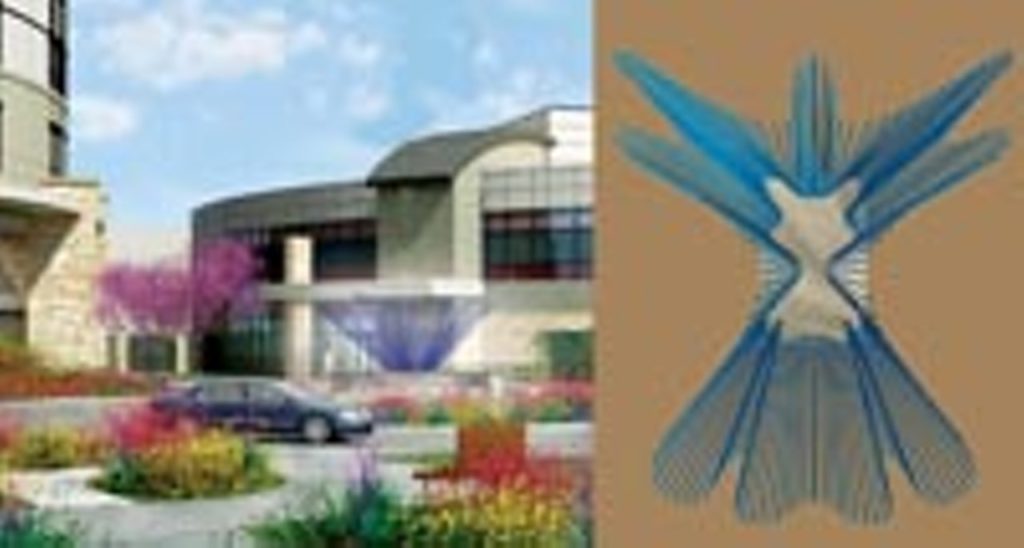
“There is a lot behind it, but however much someone gets is fine with me,” says Westover. “I like to think in terms of a sort of chaos theory: What seems very random actually has some kind of sense to it and can function as something greater than itself. It’s important for me to know that these ideas exist, but I don’t want to spell it out. All of the interpretations of a piece are valid. That’s the gift of art: that people can see it and apply their own schema and take away from it whatever they do.”
In the end, the simple act of thoughtfulness—of taking into consideration how a person gazing at this piece from a hospital window might be affected—is the genuine mark of this work. It speaks volumes to the generosity of spirit inherent in this artist.
“The Saint Alphonsus piece is such a poetic piece,” says Jacqueline Crist, whose J Crist Gallery represents Westover and arranged for this commission. “Amy has a quality that makes people want to connect with her and understand her and go with her. It is a quality that can’t be learned, an essence within the individual, and that comes through in her work as well.
“Artists [who] choose to work in the arena of public art have to be able to find satisfaction not only from making the art but also from the process in order to continue in that realm,” says Crist. “There is an incredible reward that can come from the process of site specificity, but it can be very involved. You’re not just plopping something down somewhere. It is conditional; it is a compromise; and there are expectations that have to be met. Amy has the ability to let her ego go, to listen and to be sympathetic to who is commissioning the work. It takes a group to make it happen, and the artist must have interaction with the people [who] care about the site. But the result is something bigger than the sum of its parts.”
The J Crist Gallery also represents Westover’s work in other media, outside the public realm. “With my personal work, it’s a way for me to be completely free,” Westover says. “It’s pure expression that stems from personal experiences and from the spiritual parts of my awareness. I can go to the print shop and be alone and not have to sell my concept to anybody or worry about the cost of anything.
“Amy works through a lot of media and a lot of ideas, but she still has a continuity that her work expresses,” says Crist. “There is a quality in each of the expressions that I find connected and complete. Within each media—glass, soap, prints—she completes her ideas. They are connected, conceptually. There is a wholeness throughout the work.”
For several years, Westover has been producing monotype prints on paper. This work shows a freedom of expression that provides a balance to the precisely executed public art works. Rather than carefully capturing the essence of a place outside of herself, she allows the internal to become external. Her process is open and unstructured. “When I print, I will explore an idea a thousand different ways,” says Westover. “I have to keep going until I almost exhaust it. I definitely know when I’ve got it. There is a moment where I … think, ‘ah, yeah!’ That’s when I know I’m doing something that is beyond myself.”
Westover also explores working with glass, which is a material that fits many of her concepts. “My ideas for glass are much more conceptual, almost architectural,” she says. “I keep my hands wet working in this medium by making beautiful plates. So much of my work is very loose, and with glass, there’s a very high level of craftsmanship. Plus, the end results are functional, which is part of what I like about it. In a way, glass takes on what public art does: It weaves itself into your everyday existence.”
Westover has been creating a series of lithographs printed on used bars of soap, an idea that she began developing for a show at the Basement Gallery in 2004. “The soap comes from really personal experiences,” says Westover. “The pieces are really about the purification of myself. Initially I looked at the bar of soap as a really beautiful material that becomes a nice shape. The fact that it is shaped by way of my body is intriguing. It’s very fragile, and you have to save it at a perfect point. While it is washing me on the outside, in the private moments of the bath, there is an aspect of a cleansing ritual. And the idea that soap washes away, but also leaves traces of the self on its surface fascinates me. My DNA is in each of these pieces.”
Westover has several sketchbooks full of ideas that she wants to bring into being. “A lot of artists can’t go forward because they get blocked, but I have the opposite problem,” she says. “I have so many ideas that I want to make happen that I get overwhelmed by them all. They can’t all materialize for the obvious reasons—money, time, real life, and so on. I have had the opportunity to have outlets for public art, and have been able to see things come to fruition in that forum. But I have so many different avenues for expression, and I haven’t exhausted anything. It all just keeps progressing.
As she wades deeper into the tides of the contemporary art world, Westover brings budding experience, knowledge of craft and her own strong vision with her. “You just have to put it all out there and see what comes,” she says.
There is much to come.
